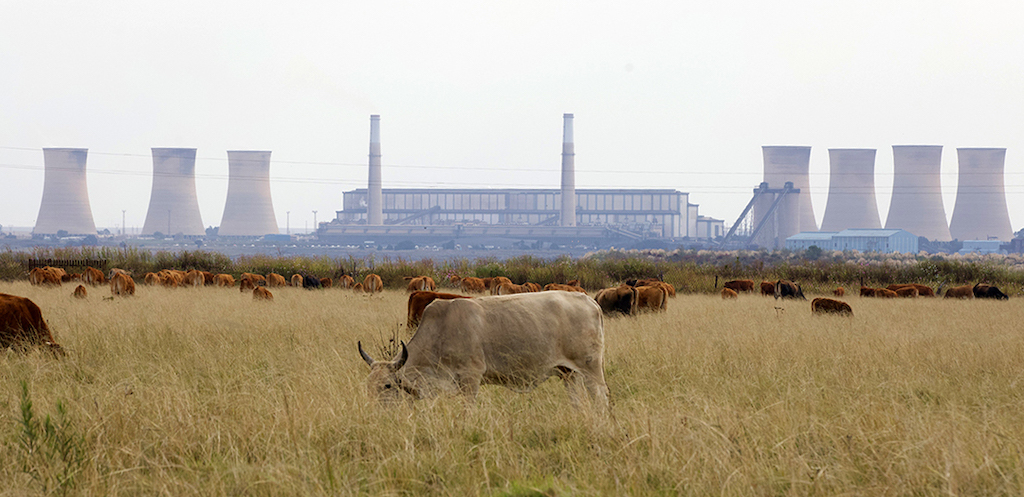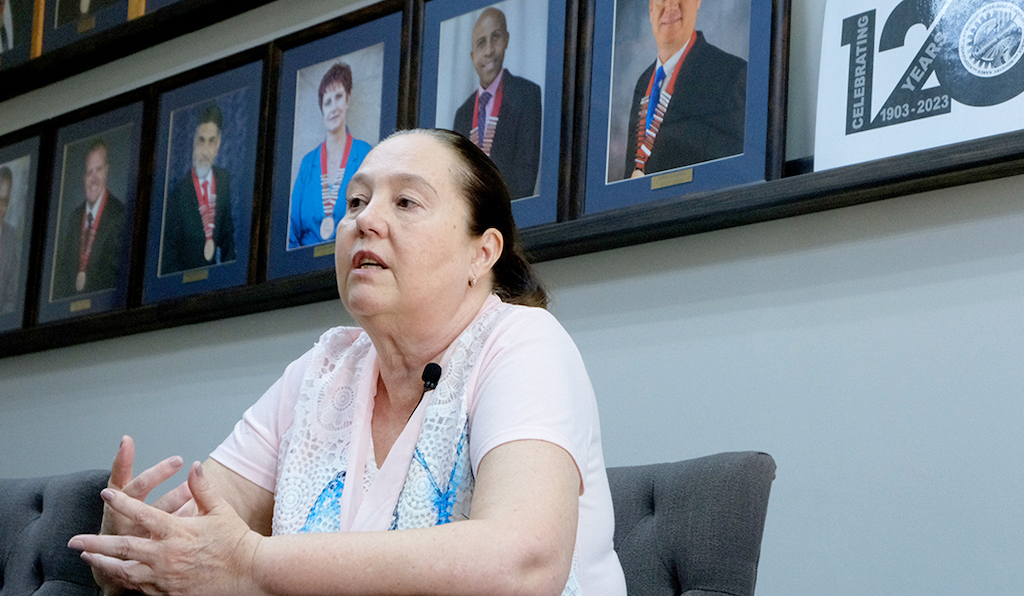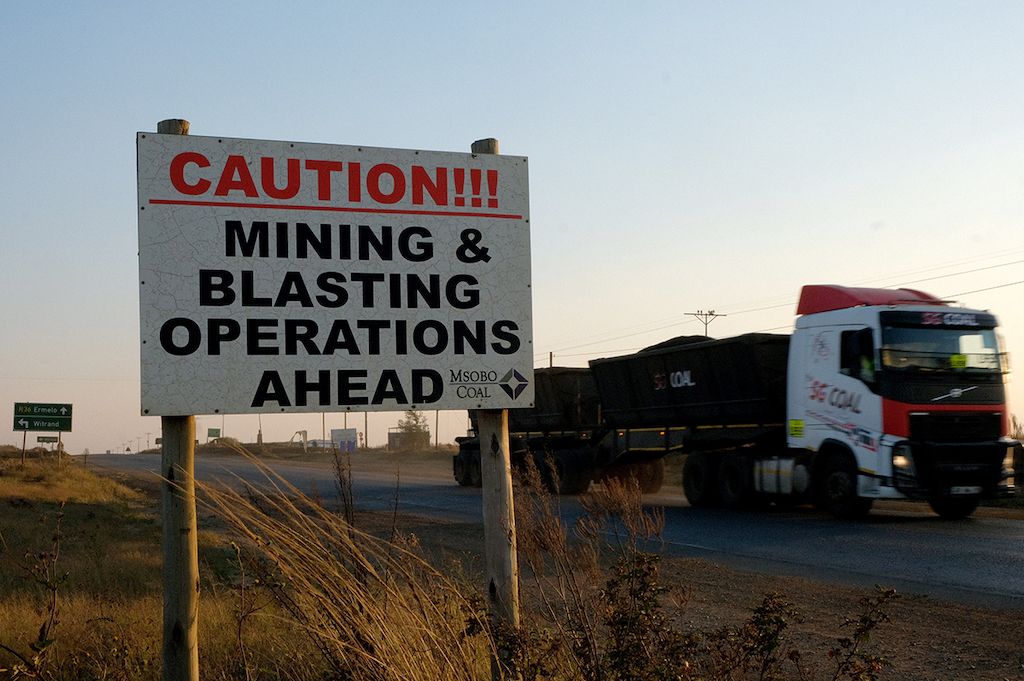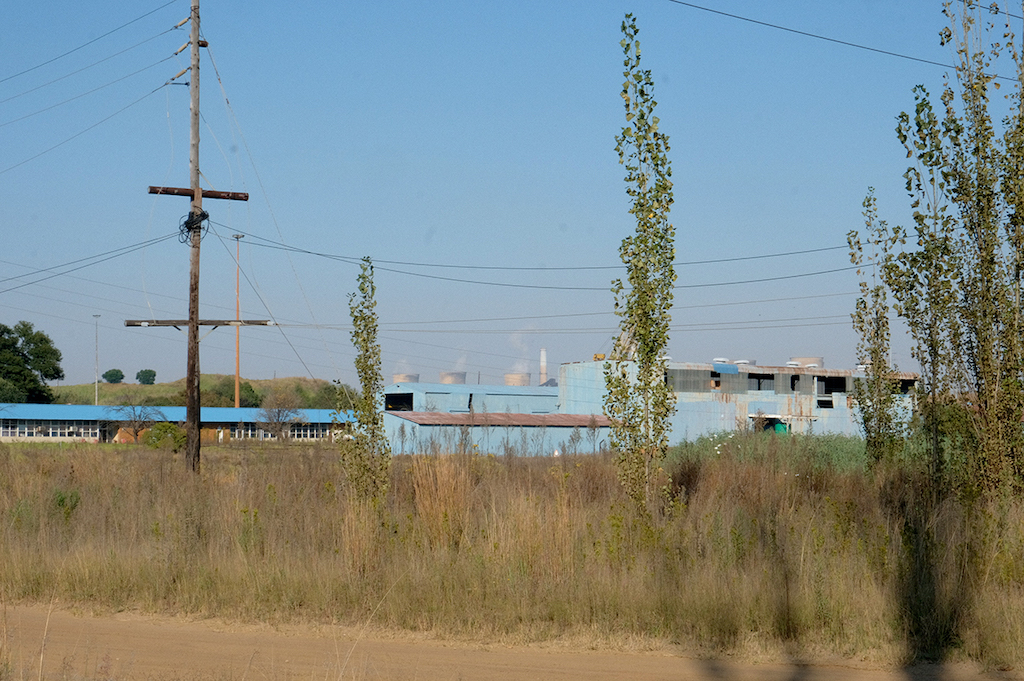
15 May A new light on the future of Eskom’s assets
A business coalition in South Africa’s energy heartland proposes a private take-over of Eskom’s assets to keep the lights on. But not everyone agrees with privatising energy production. Andiswa Matikinca reports

Hendrina Power Station: One of the country’s biggest and oldest power stations, it is set to be decommissioned between the end of 2023 and 2025. Photo: Dianah Chiyangwa
Local business interests in South Africa’s power capital are putting their “hands” up for an opportunity to participate in keeping the lights on, amid controversial plans to retire 50% of Eskom’s coal-fired plants in the coming years.
The Middelburg Chamber of Commerce and Industry (MCCI), a coalition of businesses based in the Mpumalanga coal-mining and farming belt, is proposing a private take-over and repurposing of power plants in the region being decommissioned as part of the Just Energy Transition (JET).
Anna-Marth Ott, chief executive of the MCCI, said it is important for the regional business community to ensure the economy it operates in remains strong and that their businesses run profitably. Unions, community members and employees in the coal industry are concerned their livelihoods and local infrastructure will implode as a result of the decommissioning (see Left in the dust for a greener future).
“People look at this region and it’s as if they are gleeful that the towns are going to be ghost towns and we’re going to suffer and it’s going to be the worst economic impact for us,” Ott said. “I’ve got very bad news for you – if it happens here, it will impact everybody. A large portion of the income generated through Sandton [an upscale commercial and residential district north of the city of Johannesburg] is generated here.”

MCCI CEO Anna-Marth Ott: ‘I’ve got very bad news for you – if it happens here, it will impact everybody.’ Photo: Dianah Chiyangwa
Private take-over
Ott said the private take-over concept was raised by the MCCI during a meeting with former Eskom chief executive André de Ruyter in February 2020, when the chamber pitched ideas about how business could get involved in the repurposing of Komati station. Komati is one of three power stations in the Steve Tshwete Local Municipality, and in October 2022 was the first coal-fired plant to be decommissioned.
“We really wanted Komati because the gas line [from Mozambique to Secunda] goes right past the power station, and it’s not as big as Hendrina station. We thought we could turn Hendrina into an energy generation university as well,” she said. A nearby source of gas would be an attraction to investors interested in repurposing stations from coal to gas.
After these plans failed to materialise, the chamber turned its attention to the next in line in the country’s coal power plant decommissioning plans, the Hendrina Power Station. Situated 20km from Hendrina, a small mining and farming town which falls under the Steve Tshwete Local Municipality, it is one of the country’s biggest and oldest power stations and is set to be decommissioned between the end of 2023 and 2025.
“Steve Tshwete Municipality is where Middelburg, Hendrina and Pullen’s Hope and all the towns within the region fall. So what happens in one town affects the rest of the municipality. It’s where our principal income comes from,” Ott said.
“We are working on establishing a consortium, and they will decide how this will be run. If it doesn’t work through Hendrina, we are hoping to then establish something similar within the municipal area of Steve Tshwete Municipality.”
A preferred model, according to Ott, would be to revert to the old operational plan of the former Electricity Supply Commission (Escom) which would be run as a cooperative.
Prior to the establishment of Escom in 1923 in terms of the Electricity Supply Act of 1922, power was generated by a range of different bodies, including 40 municipalities and 18 private companies. The two largest companies were the Rand Mines Power Supply Company and the Victoria Falls and Transvaal Power Company, according to research by the Alternative Information & Development Centre.
Escom was set up as a public utility to supply growing demand for a reliable and cheap source of electricity, chiefly for the mines and railways. The company changed its name to Eskom in 1987 by combining the two acronyms it was then using, Escom and Evkom.

A coal truck rumbles past Carolina: The Steve Tshwete Local Municipality is home to about 120 coal mines, but not all of them are supplying local power stations. Photo: Dianah Chiyangwa
Green energy
Although talks around future energy generation are now focused on renewable resources, Ott said there should not be a total shift away from coal due to baseload electricity demand – referring to the minimum constant level of electricity needed to meet demand.
“You need baseload to be able to run the manufacturing sector, which generates jobs and grows our economy – it cannot operate on solar power alone,” she said. “That does not mean we are not looking at green [energy], because we also need the green credits for our manufacturers so when they export to Europe and other countries they will be able to claim green credits.” She was referring to the European Union’s Carbon Border Adjustment Mechanism, which encourages partner countries to decarbonise their production processes.
Repurposing would involve multi-usage of the different units at Hendrina station, she said. “We may try hydro [power] in one, hydrogen in another and a new coal-burning system in the other. The idea is to find the most optimal green solution for energy usage in the area.”
The Steve Tshwete Local Municipality is home to about 120 coal mines, she added. “Not all of them are giving coal to the power stations – only a few are. The rest are exporting the coal, so unless things drastically change in the rest of the world, the coal mining is going to continue.”
The details around how the Hendrina take-over would work are not yet clear and no agreements have been concluded, Ott said. “We know it’s going to take a lot of money to repurpose the power station.
“It’s more expensive sometimes to repurpose, but on the other hand, if the basic infrastructure is there, why not use it? Or do you want to have [nothing but] gravestones in our region?”

Abandoned assets: Infrastructure built for Optimum coal mine near Pullens Hope crumbles after its owners, the India-born Gupta family, fled South Africa to evade prosecution over their alleged involvement in corruption. Photo: Dianah Chiyangwa
Independent operators
Outgoing Eskom chief operating officer Jan Obeholzer last month expressed support for MCCI’s plan to participate in repurposing Hendrina station. Oberholzer – who retired on April 30, but has signed a contract to stay on at Eskom in a different capacity – reportedly said independent operators will be invited by Eskom to table their plans for the plant in a public process, according to the Middelburg Observer.
Repurposing the plant into a gas-generating facility was an option and, despite his continued support for coal-powered stations due to the country’s abundance of quality coal, he reportedly said alternative energy sources should be fully explored.
Nine coal-fired power stations owned by Eskom are scheduled to be decommissioned by 2035 as part of the JET, most of them in Mpumalanga province, in an effort to reduce the electricity sector’s greenhouse gas (GHG) emissions, which made up 45% of the country’s total emissions in 2017.
South Africa’s newly appointed Electricity Minister, Kgosientsho Ramokgopa, has in recent weeks indicated that decommissioning plans are likely to be delayed to stave off ongoing loadshedding. He has also expressed interest in public-private partnerships to fund solutions for the energy crisis.
Questions sent to Eskom about the decommissioning plans at Hendrina station remained unanswered at the time of publication.

Relief for ratepayers
Officials at the Steve Tshwete Local Municipality said it supported the MCCI approach, particularly if it means reduced tariffs for electricity consumers. The municipality covers an area of just under 4,000㎢ within Mpumalanga province.
“Eskom was built in the past from small independent power producers, so the Chamber of Commerce could be successful in taking over the power station and definitely we as a municipality will support that,” said Ntokozo Gubevu, the director of electrical engineering services at the municipality. “The decommissioning and repurposing of the power plant will bring benefits in terms of power purchases.”
Currently the municipality buys electricity from Eskom and sells it on to consumers at the Eskom rate, which is constantly rising, Gubevu said. “At the municipality we are looking forward to having more IPPs [independent power producers] generating more electricity for the municipality because we believe our ratepayers will get relief from the current high electricity tariffs.”
Gubevu added that though the decommissioning of Hendrina Power Station won’t have an immediate impact on the municipal electricity supply, it will directly affect the community of Hendrina and neighbouring communities that are currently receiving services such as water directly from Eskom.
“There is a [water] pipeline going from the plant all the way to our Hendrina residential area as well as KwaZamokuhle location, so those areas will be affected by decommissioning the station and we’ll have to look at alternative ways to get the water supply to those areas,” he said.
Gaylor Montmasson-Claire, an economist at the Trade & Industrial Policy Strategies, said this might be one of the most pressing challenges arising from the decommissioning of Hendrina station.
An easy solution would be to transfer the provision of water and sanitation services to the affected areas back to the municipality. “But that still raises some questions about whether the municipality will have the resources to maintain and operate those services,” he said.

Private hands
Thomas Mnguni, a resident of Mpumalanga and a campaigner at non-profit environmental justice organisation groundWork, said he was opposed to the MCCI’s plans to privatise energy production.
“As much as we want to phase out coal, we also have to be very clear that we do not want to see our energy system in private hands,” he said. “What the Chamber of Commerce is doing is a perfect example of how our national government is planning to privatise energy generation, which is wrong.
“Whether it’s coal or renewables, we don’t want to see our energy system being privatised.”
Mnguni said MCCI’s plans to repurpose the Hendrina station and build scrubbers that would remove sulphur emissions in order to comply with air quality regulations are unrealistic.
“Given our current energy crisis, we desperately need enough energy – as in yesterday. The current estimate of refurbishing the plant is about R40-billion, so I don’t think they are being realistic,” said Mnguni. He was referring to a parliamentary response by the Department of Public Enterprises in November 2022 estimating that the repurposing of Hendrina, Camden and Grootvlei power stations in Mpumalanga for renewable sources would cost US$2,6-billion (about R44-billion).
“What I fear is that we will see increased levels of pollution that will have a negative impact on people’s health and nobody will be held accountable. We’ve seen how our government has failed in terms of air quality governance, how the health department is absent when it comes to making sure that air pollution does not affect people’s health.
“For me it’s very critical to make sure that we get our government to begin to construct renewable energy plants that will be owned by the state and the public, not the private sector,” Mnguni said.

Back to the future? Activist Ronesa Mtshweni says new mines are being proposed, but old ones such as this mine near Carolina remain unrehabilitated. Photo: Ashraf Hendricks
On the ground
Ronesa Mtshweni, an activist and founder of Womandla Community Development in Carolina, a town about 41km away from Hendrina, spoke to Oxpeckers about the fears on the ground caused by the decommissioning of the Hendrina Power Station.
“People are in fear because they benefited from that power station, they benefited from the nearby mines and now that the power station is closing down, they just don’t know what’s going to happen to them, what’s going to happen to their livelihoods,” she said.
Mtshweni said talks on the JET have not been transparent and there is little to no real awareness about it, or how people can adapt to the changes that it will bring.
“As an individual, as a community member, what I understand is a just transition is that – the word ‘just’ means that we’re all going to benefit from it. Is it true we all are going to benefit from it? Especially looking at the fact that our area is surrounded by so many mines.”
Mtshweni has been a part of the coal value chain all her life: her father was a coal mine worker and she herself worked in a coal mine for seven years. Now she is fighting against coal mining because she says she has seen the pain it has caused and the problems that communities are left to deal with.
“We have an issue of water pollution in our area, and of sound [pollution] as well. There are so many trucks moving in and out, and there are so many issues related to blasting.”
New mines are being proposed, she said, “but the mines that were done before have not been rehabilitated and none of those programmes are putting back into the community. There’s no skills development that has been done, as promised.
“I know that in Middelburg they are pushing the just transition — there are already youth programmes being developed. But what’s happening to Carolina? What’s happening to the other towns?” she asked.
This investigation by Oxpeckers Investigative Environmental Journalism, in partnership with Climate Home News, is part of our Reporting South Africa’s Renewables Revolution produced with the support of the Pulitzer Center
The Oxpeckers #PowerTracker project is supported by the African Climate Foundation’s New Economy Campaigns Hub
